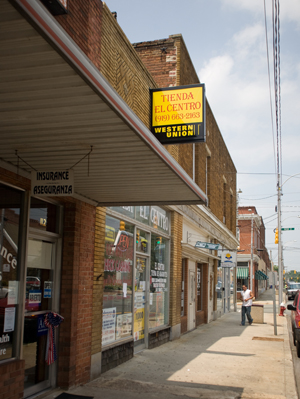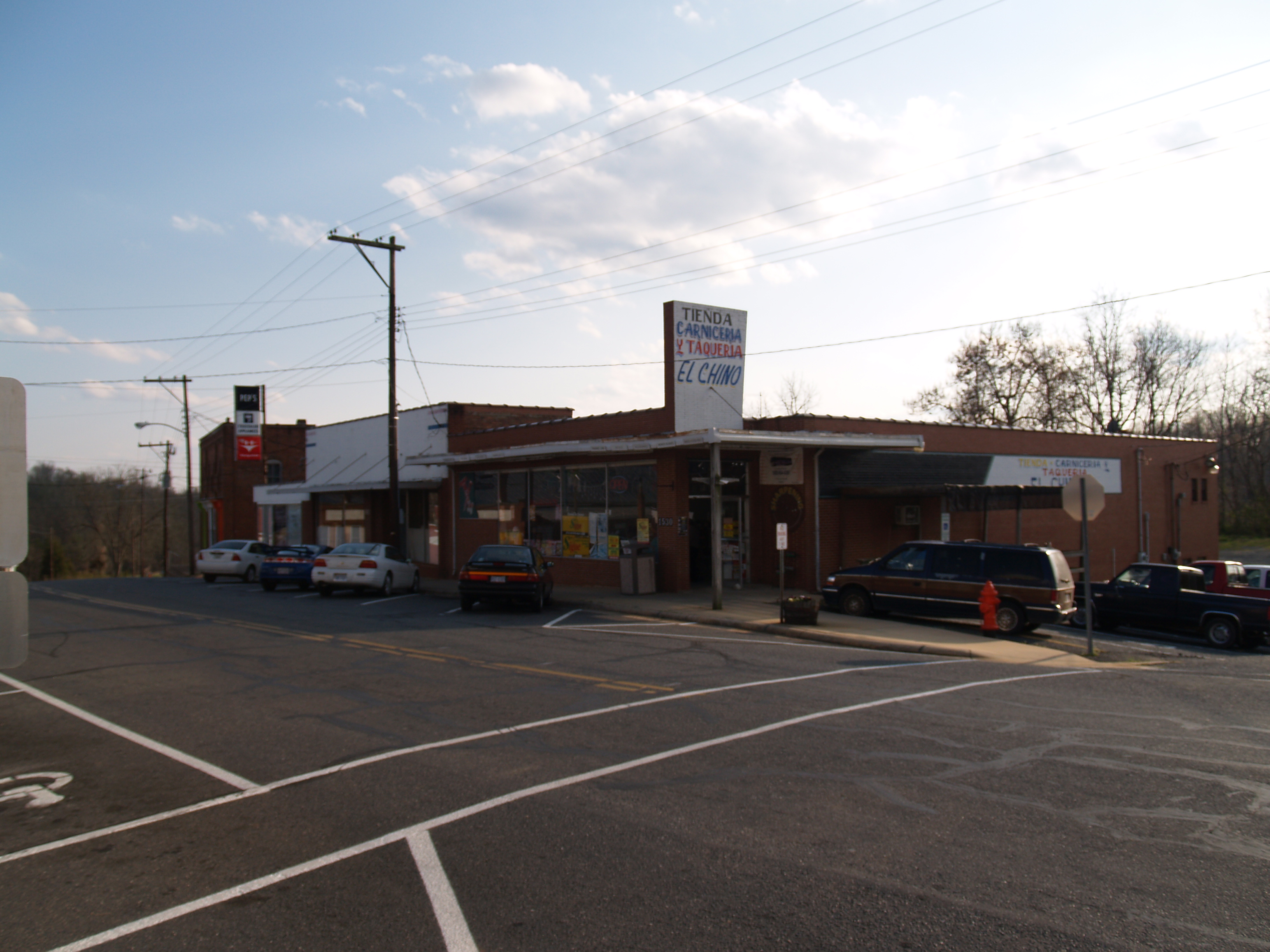Blue Highways: Greenville, North Carolina
Click on Thumbnail for MapUnfolding the Map
William Least Heat-Moon (LHM) drops in on Greenville, North Carolina and reflects on weather and what he must listen to in order to get a shower. I won't say that we will shower with him, but we will reflect on weather and on religion. To see where we are, click on the map. Comments always welcome and encouraged.
Book Quote
"At Greenville, I stopped for the night on the campus of East Carolina University. Out of the west, with suddenness, a nimbo-stratus cloudbank like a precipice obscured the sun, and a ferocious wind pulled the fine sandy soil into a corrosive blast. Then the wind ceased, raindrops pelted the sand back into place, the temperature dropped from eighty degrees to sixty-five, the clouds blew on toward the sea, and the low sun shone again. The whole demonstration lasted twenty minutes.
"That evening, I bought a hot shower in a dormitory. It cost a dollar contribution and a thirty-minute I FOUND IT bumper-sticker talk intended to drive the infidel from my red heart and bring me safely unto the Great White Bosom. Take the land, take the old ways, Christian soldiers, but please, goddamnit, leave me my soul."
Blue Highways: Part 2, Chapter 5
 Downtown Greenville, North Carolina in sunny times
Downtown Greenville, North Carolina in sunny times
Greenville, North Carolina
Weather and religion subtly and forcefully influence how we look at life, and their effects on us sometimes aren't too far apart, in my experience. For example, I wake up in the morning and look outside. If the sky is blue and the day is temperate, it immediately affects my mood and I make choices based on what I might be able to do. I can ride my bike to work instead of taking the car. I might schedule more outdoor activities for myself. If it's a work day, I can eat my lunch outside. If not, my activities on my day off can be focused more on the outdoors. A sunny day can certainly affect my mood as well. Usually I will feel more buoyant and alive.
But if the day is dark and stormy, or even overcast, my mood will be much different. I might be put in a more reflective mood, or perhaps even if I am in some kind of emotional distress or despair, the weather can amplify my feelings. Activities might be confined indoors.
Religion can leave me with similar feelings and reflections. I am nominally a Catholic, though I am pretty open to all religious views (except maybe for the ones that try to make me out to be somehow misguided or even evil because I don't accept their particular narrow focus). There are days when I feel that my individual spirituality is a great boon and support in my life. The effects on me can be pretty noticeable, especially on my mood and on my outlook for myself and how I feel about those arouund me.
There are times, however, when I can feel that my religion and spirituality isn't helping me at all. This is usually when I'm hurting for some reason. I might wish that there was something or someone out there that would hear and see my pain and ease my troubles, but nothing happens and I continue to hurt. I might question whether it is any use to even be religious.
I find that weather and religion can be very similar in that when times are good, and days are sunny, we take it for granted. We don't think about the possibility that we might eventually hurt or that the clouds, wind and rain will roll in because we want to live in the moment and enjoy our blue skies and the peacefulness we feel in our hearts.
I'm focusing on these two things because LHM touches on both of these phenomenon in his back-to-back paragraphs set in Greenville. He highlights how a storm roars through, blocking the sun and dropping rain along with the temperature. Eventually the storm passes, and the sun shines again. He then must endure a 30 minute talk on faith in order to get a shower. I have to think that he intentionally placed these two passages about a storm and his experience together, but maybe not.
Once, when I lived in Milwaukee, I watched a sunny day with 80 degree weather turn into a cloudy, windy 40 degree day with snowflakes dotting the air, all in the space of 30 minutes. The violence of the atmospheric turmoil that turned such a nice day into something so different made a huge impression on me. Similarly, while driving up to Colorado from New Mexico, my wife and I passed beneath a storm front. A huge wall of clouds loomed ahead of us, and it almost seemed like the "mother ship" from a different planet, sort of like those huge ships that hovered over major cities in Independence Day, had appeared to wreak devastation and destruction in the form of highly torrential rains. We moved from New Orleans a year before Katrina hit, but hurricanes are the most bizarre form of violent weather I have ever seen. One knows that the hurricane is out there, ready to slam ashore and wreak violence, yet while skies are blue and the wind is calm the radio and television are urging people to get out. It's almost hard to be serious about it when the weather is so nice, even if the hurricane is only a day away.
Religion can also be violent and stormy. In the U.S., we are currently in a great debate about religion, particularly Christianity, and its proper place in American society. Is it pre-eminent, or one religion among many in a diverse country? The debate has been particularly stormy, as thundering commentators send barbs at each other like lightning through the media. While some, myself included, think that religion is a private matter that we can indulge in public with our particular religious communities, what you worship and how you worship has become a huge public debate. Lately, the storm is over the proposed site of an Islamic community center in Manhattan.
Of course, a great number of people have died fighting for, or defending, their religion and their beliefs. Like the weather, religious and anti-religious sentiment can get whipped up and move through the landscape, and people can die just as in the aftermath of a particularly violent hurricane or a powerful tornado. In my experience, I saw such stormy religious sentiment in Northern Ireland, when the Protestant Orangemen of Portadown and Belfast marched toward police and army barriers protecting the (nominally) Catholic areas. The clash between Protestant traditions and Catholic fears and fortitude resembled a thunderstorm, with the Lambegh drums of the Orangemen providing the thunder.
More and more, I hope for calm skies and sunny weather, and peace in my heart and soul. I want to try to live a life that keeps drama to a minimum, and satisfaction and happiness to a maximum. If a sunny day will do that for me, I'm all for it. If I can gather together with friends and acquaintances and enjoy their company and know they enjoy mine, then I don't care what they believe or don't believe. In my particular religious tradition, acceptance and forgiveness are the tenets that should be followed. I don't want to create storms, but I do want people, no matter what their religious convictions, to help me weather any that come my way.
If you want to know more about Greenville
Blog Greenville
City of Greenville
The Daily Reflector (newspaper)
Dine Greenville
East Carolina University
The East Carolinian (campus newspaper)
Greenville Convention and Visitors Bureau
Greenville Times (newspaper)
Wikipedia: Greenville
Next up: Plymouth, North Carolina




 Friday, September 3, 2010 at 3:01PM
Friday, September 3, 2010 at 3:01PM



